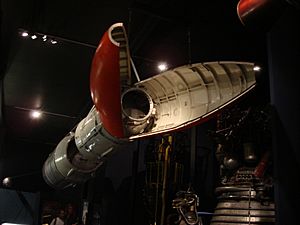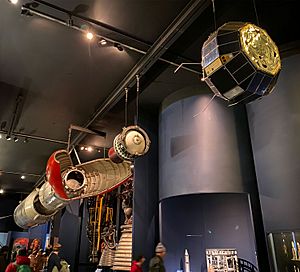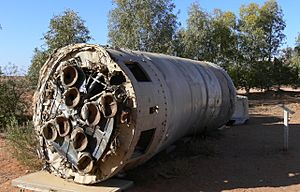Black Arrow facts for kids

A mockup of the Black Arrow in the rocket park at Woomera.
|
|
| Function | Carrier rocket |
|---|---|
| Manufacturer |
|
| Country of origin | United Kingdom |
| Size | |
| Height | 13 metres (43 ft) |
| Diameter | 2 metres (6 ft 7 in) |
| Mass | 18,130 kilograms (39,970 lb) |
| Stages | 3 |
| Capacity | |
| Payload to LEO | 135 kilograms (298 lb) |
| Payload to LEO | 102 kilograms (225 lb) |
| Launch history | |
| Status | Retired |
| Launch sites | Woomera LA-5B |
| Total launches | 2 (+2 suborbital) |
| Successes | 1 (+1 suborbital) |
| Failures | 1 (+1 suborbital) |
| First flight | 27 June 1969 |
| Last flight | 28 October 1971 |
| First stage | |
| Engines | Gamma 8 |
| Thrust | 256.4 kilonewtons (57,600 lbf) |
| Specific impulse | 265 seconds (2.60 km/s) |
| Burn time | 131 seconds |
| Fuel | RP-1/HTP |
| Second stage | |
| Engines | Gamma 2 |
| Thrust | 68.2 kilonewtons (15,300 lbf) |
| Specific impulse | 265 seconds (2.60 km/s) |
| Burn time | 116 seconds |
| Fuel | RP-1/HTP |
| Third stage – Waxwing | |
| Engines | 1 solid |
| Thrust | 27.3 kilonewtons (6,100 lbf) |
| Specific impulse | 278 seconds (2.73 km/s) |
| Burn time | 55 seconds |
| Fuel | Solid |
The Black Arrow was a special British rocket designed to carry satellites into space. It was built in the 1960s and launched four times between 1969 and 1971. All its launches happened from the Woomera Prohibited Area in Australia.
Its last flight was a big success for the United Kingdom. It was the first and only time the UK successfully launched a satellite into orbit using its own rocket. This satellite was called Prospero and it went into low Earth orbit.
The idea for Black Arrow came from earlier rocket studies by the Royal Aircraft Establishment. The project got approval in 1964. It was first developed by a company called Saunders-Roe, which later joined with Westland Aircraft.
Black Arrow was a three-stage rocket. It used a special fuel called RP-1 (a type of kerosene) and high test peroxide (a strong form of hydrogen peroxide). The program was stopped after only four launches. The government decided it was cheaper to use American Scout rockets instead.
Contents
Building the Black Arrow Rocket
The Black Arrow project started when the Royal Aircraft Establishment suggested building a rocket. This rocket would be able to carry a 317-pound (144 kg) payload into low Earth orbit. The goal was to test new systems for bigger spacecraft.
In 1964, the government approved the project. However, a new government later paused it to save money. After another election, the project was approved again, but with fewer test launches. The first launch was planned for 1968.
Most of the technology for Black Arrow was already proven. It came from earlier rockets like the Black Knight and the Blue Steel missile. The idea was to reuse as much as possible to save money and make development easier. Many engineers from the Black Knight project moved to Black Arrow.
Saunders-Roe started the development, but then merged with Westland Aircraft in 1964. Westland Aircraft became the main company building Black Arrow. They put together the first and second stages of the rocket in Cowes on the Isle of Wight.
The engines for the first and second stages were made by Bristol Siddeley in Ansty, Warwickshire. They were tested there before being sent to the Isle of Wight. The third stage was made by Bristol Aerojet in Somerset. Its solid fuel was made in Waltham Abbey, Essex.
The name Black Arrow came from a special naming system used by the British military. This system used a color and a noun for research projects. People also unofficially called it the "Lipstick Rocket." This was because its nose cone was painted bright red, making it look like a tube of lipstick.
How the Rocket Worked
The first and second stages of Black Arrow used RP-1 paraffin (kerosene) fuel. They burned it with high test peroxide as an oxidizer. Because of the way these chemicals mixed, the rocket needed a larger tank for the oxidizer.
The oxidizer tanks were placed below the fuel tanks. This design put the heavier liquid at the top. It helped the rocket stay stable during flight by moving its center of gravity higher. This made the rocket easier to control.
The rocket used a system called Thrust vectoring to steer its first two stages. The first stage had eight engine chambers. They were arranged in pairs that could pivot. This allowed the rocket to control its roll, pitch, and yaw. The second stage had two engine chambers that could also pivot, providing the same control. After the second stage stopped firing, a special system controlled the rocket's direction. The third stage spun around to stay stable.
The first stage was powered by a Gamma 8 engine. This engine burned for 127 seconds. It was 6.9 meters long and 2 meters wide. The 2-meter width was chosen to match the French Coralie rocket stage. This was done so Black Arrow could potentially work with the Europa rocket, which used the British Blue Streak as its first stage.
The first and second stages were connected by a structure that helped them separate. This structure had small motors that fired seven seconds after the first stage stopped. Six seconds later, the structure separated from the second stage. The second stage was 2.9 meters long and 1.37 meters wide. It had a Gamma 2 engine that burned for 123 seconds. About three minutes after launch, the payload fairing (the nose cone protecting the satellite) separated.

About 257 seconds into the flight, the second stage stopped firing. The rocket then coasted upwards to its highest point, called apogee. During this coast, the rocket used its control system to stay pointed in the right direction for the third stage to separate.
Near the end of the coast, the third stage was spun up to 3 times per second (180 rotations per minute) by small rockets. Five seconds later, the third stage separated. After ten more seconds of coasting, it ignited. The third stage was a Waxwing solid rocket motor, which burned for 55 seconds.
Just over a minute after the third stage finished burning, the satellite was released. Small gas generators pushed the satellite and the used upper stage apart. This delay was meant to prevent the upper stage from accidentally hitting the satellite. However, during the R3 launch, the upper stage still bumped the Prospero satellite, damaging one of its antennas. Even so, the satellite successfully completed its mission. The entire journey from liftoff to satellite release on the R3 launch took about 710 seconds.
Some ideas were proposed to make Black Arrow carry heavier payloads. One idea was to add eight Raven solid rocket motors to the first stage. Another was to put the entire Black Arrow rocket on top of a Blue Streak missile. A third idea was to use more powerful engines called Larch instead of the Gamma engines. None of these ideas were ever built.
Black Arrow Launches
Four Black Arrow rockets were launched between 1969 and 1971. The first two launches were test flights. They carried heavy, non-working third stages and simple test payloads.
On the very first flight, an electrical problem caused part of the first stage to move incorrectly. The rocket rolled unevenly right after leaving the launch pad. About a minute later, it started to break apart. When the first stage engine failed, the rocket began to fall. It was then destroyed by the safety team on the ground.
The second launch was successful. The third launch, on September 2, 1970, was the first attempt to launch a real satellite. This launch failed because of a leak in the second stage. The third stage did fire, but the rocket did not reach orbit. It fell back to Earth over the Gulf of Carpentaria.
The fourth launch was a success! It put the Prospero satellite into orbit. This made the United Kingdom the sixth country to launch its own satellite using its own rocket. The satellite was named Prospero after a character in Shakespeare's play The Tempest. The name was chosen because, in the play, Prospero gives up his magic powers, just as the Black Arrow program was ending.
All four launches happened from Launch Area 5B in the Woomera Prohibited Area in Australia. This site had been used before for testing the Black Knight rocket. Other possible launch sites in Barbados, Uist, and Norfolk were considered but rejected.
| Serial number | Launch date/time (GMT) | Payload | Outcome | Remarks |
|---|---|---|---|---|
| R0 | 28 June 1969, 22:58 | None | Failure | Test of first and second stages, steering system failed. |
| R1 | 4 March 1970, 21:15 | None | Success | Successful test of first and second stages. |
| R2 | 2 September 1970, 00:34 | Orba | Failure | Second stage had a pressure problem. |
| R3 | 28 October 1971, 04:09 | Prospero | Success | Successfully reached Earth orbit. |
| R4 | Not launched | Now in the Science Museum in London. | ||
Why Black Arrow Was Stopped
The government announced that the Black Arrow project would be stopped on July 29, 1971. However, the R3 rocket had already been sent to the launch site, so they allowed it to be launched.
The program was canceled to save money. The government decided it would be cheaper to use American Scout rockets for future launches. These rockets could carry similar payloads. Before Black Arrow was canceled, NASA had offered to launch British satellites for free. But this offer was taken back after the decision to stop Black Arrow.
The last Black Arrow rocket ever built was R4. It never flew and is now kept in the Science Museum in London. A spare Prospero satellite is also there. There is also a copy of the Black Arrow rocket in the Rocket Park at Woomera.
The remains of the first stage of Black Arrow R3 were found on a cattle farm in Australia. They were displayed in a park, but due to weather and damage, they were brought back to the United Kingdom. As of 2021, this rocket part is on loan to the Farnborough Air Sciences Trust Museum.
The launch facilities at Woomera were taken down within a year of the last flight. Half of the engineers who worked on the program lost their jobs. The X-4 satellite, which was supposed to be launched by Black Arrow R4, was eventually launched by an American Scout D-1 rocket in 1974.
As of 2022, the United Kingdom is the only country that has successfully built and launched its own satellites, but then stopped its program. Other countries that developed this ability have kept it.
See also
- Comparison of orbital launchers families
- Comparison of orbital launch systems
- Ariel 1
- British National Space Centre
- Diamant
- Juno I
- Lambda (rocket family)
- Satellite Launch Vehicle
- Sputnik (rocket)
- Black Knight





